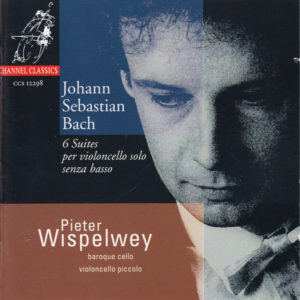
Pieter Wispelwey 1998.
Pieter Wispelwey. Bach Cello Suites. Channel Classics CCS 12298 CD
Recorded January 1998 at the Church of Valkkoog Netherlands.
Recording details: Schoeps microphones, 24 bit Prism/Genex Recorder.
Monitoring: Monitor Audio speakers, AKG K1000 headphones.
Cellos: Baroque cello Barak Norman 1710 & violoncello piccolo (anon 18thcentury.
Introduction.
Wispelwey has recorded the Suites on 3 separate occasions to date, starting in 1990 and his most recent being 2012. This version may then be considered the filling of the sandwich, being the middle rendition!
The Cellist.
Wispelwey is featured regularly in the critic’s top 5 recommendations of the Suites. Indeed he is often their first choice. His teachers include Anner Bylsma and William Pleeth, underlining his ability to perform in both modern and Baroque style. I would describe this recording as being in the Baroque style on period instruments. It falls short of being a totally authentic period rendition, in terms of bow used but I suspect gut strings were used.
I would have welcomed details of this in the otherwise excellent notes provided by Wispelwey himself.
The acoustic of the recording is light and airy. The cello appears not to have been as close miked as some modern recordings but the performer’s unobtrusive breathing is heard at times.
The Music.
Overall the style of playing is very attractive. Every note is made to count, each phrase is clearly part of an ongoing conversation. There is a lot of rubato but also preservation of the underlying rhythms. In summary, stylish delicate and refined.
Some may not particularly like the the lighter bowing with more surface noise of bow on string, but I find it brings out the upper harmonics in the music with benefit.
The performer plays all the repeats, in general quieter the second time around and with some variation of the ornamentation.
Wispelwey plays the Suites consecutively, through the 2 CDs, with significant pauses between each movement.
The recording in more detail.
First Suite.
In the first Suite of the Prelude Wispelwey plays in an understated and reflective manner, but with plenty of light and shade. The Courante sounds quite skittish but with a lot of variation in tone, so much so that some of the key notes seem over-emphasised for my taste. The Sarabande starts with rather a heavy feel but soon lightens and softens. The Gigue is fast and very light of foot.
Second Suite.
The second suite has a very sombre sound as befits the minor key. More noticeable in this recording than many.
Reference to the notes indicates that Wispelwey highlights the keys of each Suite and attributes different characteristics of each Suite according to the key it is written in. There is a very reverential Allemande, contrasting with the Courante which is played in a bold and vivacious manner. Again there is a firm start to the Sarabande which then softens.
Third Suite.
In the Prelude of Suite 3 the pace is rapid, with possibly some loss of detail particularly in the lower notes. The Courante for me is the highlight of this Suite being performed in a very assertive and dynamic manner. There is particular definition of the staccato sections . The Gigue is raucous and sometimes a little brusque in sound, no doubt intentioned. This dance seems to have some of the greatest variation in speed but still with rhythm intact.
Fourth Suite.
In the 4thSuite Prelude there is play with more style and delicacy than most. It sounds as if Wispelwey is carefully walking along a path taking pains to avoid treading on any flowers that have popped up amongst the slabs. He becomes more heavy footed in the mid section but lightens again with a moderately assertive end. Wispelewey plays the Bourees in a very light style imitating the almost floating appearance of the Brownlee brothers’ running.
Fifth Suite.
In Suite 5 the Sarabande is noticeably brisker than many and with articulation between notes in some sections as opposed to slurring. However, there was preservation of the reflective nature of this movement.
Sixth suite.
In the final Suite the artist uses a piccolo cello. Its use, no doubt to lend a particular character to the top end of the performance. The higher notes standing out seems to enhance the contrapuntal nature of the music. The use of this particular cello gives the lower registers a more mellow sound than the use of the Baroque cello in the previous 5 Suites. All of this adds to the attractiveness of this particular performance.
Conclusion.
In summary, I would suggest that the critics are absolutely correct in recommending Wispelwey’s performances. The listeners only problem is deciding which one to go for. Between myself and Mark, we aim to cover all 3 recordings, but you may need to make your own mind up after purchasing all 3!
Charles.